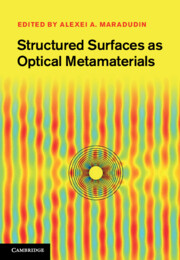Book contents
- Frontmatter
- Contents
- List of contributors
- Preface
- 1 Physics of extraordinary transmission through subwavelength hole arrays
- 2 Resonant optical properties of nanoporous metal surfaces
- 3 Optical wave interaction with two-dimensional arrays of plasmonic nanoparticles
- 4 Chirality and anisotropy of planar metamaterials
- 5 Novel optical devices using negative refraction of light by periodically corrugated surfaces
- 6 Transformation of optical fields by structured surfaces
- 7 Surface electromagnetic waves on structured perfectly conducting surfaces
- 8 Negative refraction using plasmonic structures that are atomically flat
- 9 Anomalous transmission in waveguides with correlated disorder in surface profiles
- 10 Cloaking
- 11 Linear and nonlinear phenomena with resonating surface polariton waves and their applications
- Index
- Plate section
- References
7 - Surface electromagnetic waves on structured perfectly conducting surfaces
Published online by Cambridge University Press: 01 June 2011
- Frontmatter
- Contents
- List of contributors
- Preface
- 1 Physics of extraordinary transmission through subwavelength hole arrays
- 2 Resonant optical properties of nanoporous metal surfaces
- 3 Optical wave interaction with two-dimensional arrays of plasmonic nanoparticles
- 4 Chirality and anisotropy of planar metamaterials
- 5 Novel optical devices using negative refraction of light by periodically corrugated surfaces
- 6 Transformation of optical fields by structured surfaces
- 7 Surface electromagnetic waves on structured perfectly conducting surfaces
- 8 Negative refraction using plasmonic structures that are atomically flat
- 9 Anomalous transmission in waveguides with correlated disorder in surface profiles
- 10 Cloaking
- 11 Linear and nonlinear phenomena with resonating surface polariton waves and their applications
- Index
- Plate section
- References
Summary
Introduction
The ability to localize electromagnetic energy below the diffraction limit of classical optics featured by surface plasmon polaritons (SPPs) (electromagnetic surface waves sustained at the interface between a conductor and a dielectric) is currently being exploited in numerous studies ranging from photonics, optoelectronics, and materials science to biological imaging and biomedicine [1]. While the basic physics of SPPs has been described in a number of seminal papers spanning the twentieth century [2, 3], the more recent emergence of powerful nanofabrication and characterization tools has catalyzed a vast interest in their study and exploitation. The dedicated field of plasmonics [4] brings together researchers and technologists from a variety of disciplines, with the common aim to take advantage of the subwavelength light confinement associated with the excitation of SPPs.
Most interest is focused on the optical regime, where SPPs are strongly confined to the respective metal/dielectric interface, i.e. where subwavelength mode localization is achieved in the direction perpendicular to the interface. These strongly confined SPPs occur at frequencies which are still an appreciable fraction of the intrinsic plasma frequency of the metal in question. In this regime, the motion of the conduction electrons at the interface is dephased with respect to the driving electromagnetic fields, leading to a reduction in both phase and group velocities of the SPP, and, therefore, to strong localization. A considerable fraction of the SPP field energy resides inside the conductor.
- Type
- Chapter
- Information
- Structured Surfaces as Optical Metamaterials , pp. 232 - 268Publisher: Cambridge University PressPrint publication year: 2011
References
- 3
- Cited by



